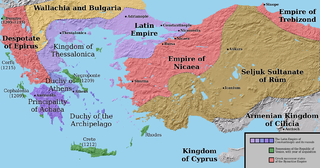
The Principality of Achaea or Principality of Morea was one of the vassal states of the Latin Empire, which replaced the Byzantine Empire after the capture of Constantinople during the Fourth Crusade. It became a vassal of the Kingdom of Thessalonica, along with the Duchy of Athens, until Thessalonica was captured by Theodore, the despot of Epirus, in 1224. After this, Achaea became for a while the dominant power in Greece.

Philip I of Taranto, of the Angevin house, was titular Latin Emperor of Constantinople by right of his wife Catherine of Valois–Courtenay, Despot of Romania, King of Albania, Prince of Achaea and Taranto.
William I de la Roche succeeded his brother, John I, as Duke of Athens in 1280. He was the son of Guy I de la Roche.
The margraviate or marquisate of Bodonitsa, today Mendenitsa, Phthiotis, was a Frankish state in Greece following the conquests of the Fourth Crusade. It was originally granted as a margravial holding of Guy Pallavicini by Boniface, first king of Thessalonica, in 1204. Its original purpose was to guard the pass of Thermopylae.
Nicholas II Zorzi or Giorgi was the Margrave of Bodonitsa, a member of the Zorzi family of the Republic of Venice, from 1410 to 1414. He was the last Venetian margrave to actually rule before the Ottoman Turkish conquest.
Nicholas ΙΙΙ Zorzi or Giorgi was the Marquess of Bodonitsa, a member of the Zorzi family of the Republic of Venice, from 1416 to 1436, though the title was purely nominal by then. Before becoming marquess in an exchange with his nephew Nicholas II, he was the baron of Carystus. He was a son of Guglielma Pallavicini and Marquess Nicholas I Zorzi.
Guy or Guido Pallavicini, called Marchesopoulo by his Greek subjects, was the first marquess of Bodonitsa in Frankish Greece from 1204 to his death in or shortly after 1237. He was one of the most important Frankish rulers in Greece, and played a major role in the short-lived Kingdom of Thessalonica: in 1208–1209 he supported the Lombard rebellion against King Demetrius of Montferrat, but by 1221 he was the kingdom's regent (bailli), and was left to defend the city against the ruler of Epirus, Theodore Komnenos Doukas. Left unsupported by the Latin Empire, and with a projected crusade to relieve the city delayed, he surrendered the city in December 1224. The belated arrival of the crusade helped to save his own fief from falling to the Epirotes, however, and he was soon able to return there, dying on or shortly after 1237.
UbertinoPallavicini was the son and successor of Guy as Marquess of Bodonitsa in 1237.

The House of Pallavicini, also known as Pallavicino and formerly known as Pelavicino, is an ancient Italian noble family founded by Oberto II Pelavicino of the Frankish Obertenghi family.
Thomas Pallavicini was the marquess of Bodonitsa following a disputed succession in 1286. He was the grandson of Rubino, younger brother of Guy, the first margrave.
Albert Pallavicini was the fifth marquess of Bodonitsa from his father's death until his own in 1311. His father was Thomas, a great-nephew of the first marquess, Guy. Albert married Maria dalle Carceri, a Venetian noblewoman from Euboea. He even obtained a sixth of that island.

Anthony le Flamenc was an early 14th-century Frankish knight and lord of Karditsa in the region of Boeotia, in the Duchy of Athens.
Maria dalle Carceri was sovereign marchioness of Bodonitsa from 1311 until 1323. She succeeded her late spouse Albert Pallavicini on his death in 1311. While she avoided submitting her principality to the Catalan Company, she could not avoid paying an annual tribute of four destriers.
Andrea Cornaro of the House of Cornaro, was a Venetian citizen from Crete, and baron of Scarpanto. He was the husband of Maria dalle Carceri, heiress of a sixth of Euboea and widow of Albert Pallavicini, and co-governed her half of the marquisate of Bodonitsa until his death.

Guglielma Pallavicini, the Lady of Thermopylae, was the last Pallavicino heir to rule in Bodonitsa, in Frankish Greece.
Jacob Zorzi was the Marquess of Bodonitsa from 1388 to 1410. He was the last considered true ruler of the Frankish state of Bodonitsa.

The Triarchy of Negroponte was a crusader state established on the island of Euboea after the partition of the Byzantine Empire following the Fourth Crusade. Partitioned into three baronies run by a few interrelated Lombard families, the island soon fell under the influence of the Republic of Venice. From circa 1390, the island became a regular Venetian colony as the Realm of Negroponte.

Mendenitsa, in the Middle Ages known as Mountonitsa (Μουντονίτσα) and Bodonitsa, Boudonitsa, or Vodonitsa (Βοδονίτσα), is a village in Phthiotis, Greece. Along with the nearby village of Karavidia, it forms a community in the municipal unit of Molos.

The Barony of Akova was a medieval Frankish fiefdom of the Principality of Achaea, located in the mountains of eastern Elis in the Peloponnese peninsula in Greece, centred on the fortress of Akova or Mattegrifon. It was among the twelve original baronies of Achaea, but was conquered by the Byzantines in 1320.
Margaret of Villehardouin was the daughter of William II of Villehardouin, Prince of Achaea, and his third wife Anna Komnene Doukaina.






